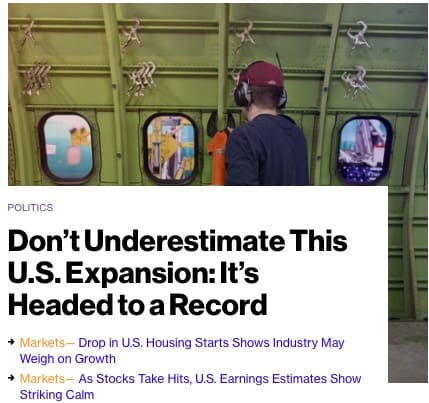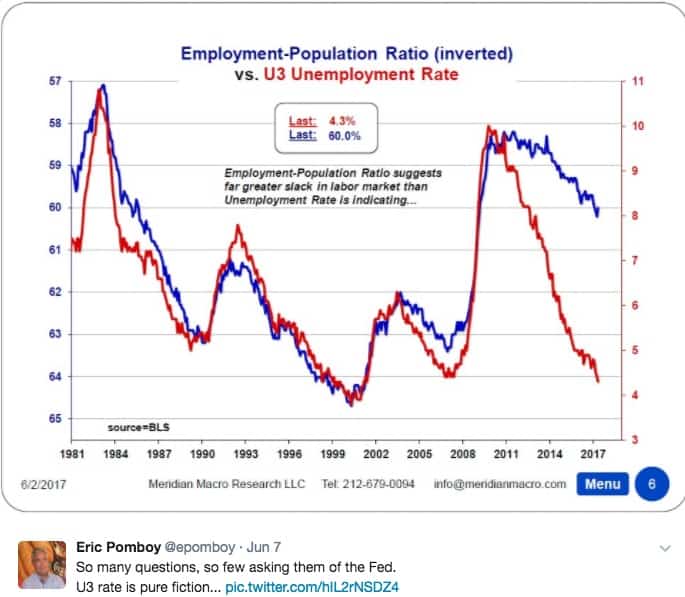Global macro economic data has been weak for many years, but there’s now a very real chance of a world-wide recession happening in 2017.
Why? A dramatic and worsening shortfall in new credit creation.
The world’s major central banks have, again, done the world an enormous disservice. Instead of admitting that maybe/perhaps/possibly the practice of issuing debt at more than twice the rate of underlying economic growth was a very bad idea over the past several decades, they instead doubled down and created an even larger debt monster to be dealt with.
The resulting global asset price bubble -- or, more accurately, set of nested and incestuously intertwined bubbles -- can collectively be called the Mother Of All Bubbles (MOAB). None has ever been larger in history.
As with all prior bubbles, it shares the collective delusion that there's such a thing as a free lunch. History has seen many attempts to eat this elusive meal, with each generation convinced that they were the chosen ones who could finally crack that nut.
So, dutifully, our central bankers have tried, and tried again, to deliver that free lunch -- i.e. to print up prosperity.
But, alas, prosperity cannot be printed out of thin air. All that can be accomplished by central bank slight of hand is a transfer of wealth. Central banks steal from the many to give to the few. They are the reverse Robin Hoods of our day.
They also encourage everyone to steal from the future, which is what excessive borrowing really represents. It's future consumption taken today at the expense of tomorrow.
The most charitable thing that can be said about the central banks is that perhaps they actually believed their own BS, but I seriously doubt it. Even the most dense of observers has noticed by now that we are 9 years into the ‘emergency measures’ and nothing even remotely close to healthy economic growth has emerged.
One year of emergency measures is already a bit too long. 3 years is embarrassing. 9 years tells you that the Fed isn’t in this for the reasons they state. Instead, they are orchestrating the largest wealth transfer in all of history, from the many to the few.
Once you realize this is their goal, then they've succeeded amazingly. Mission accomplished!
We have the widest wealth and income gaps in all of history. The big banks have complete control of the political and financial machinery of every country of the world. And the corporate controlled media simply cheerleads the whole thing, convincing most people it's all been for their own good.
Honestly, from a planning and execution standpoint, I have to give the central banking cartel very high marks for pulling off such a magnificent heist almost completely undetected by the average person.
Of course, they needed lots of assistance from a complaint media.
Economic Propaganda
Propaganda – noun - information, especially of a biased, emotionally charged or misleading nature, used to promote a political cause or point of view.
Let’s turn now to exploring the ways that the media serves to deliver propaganda instead of providing useful context and essential information.
People are anxious these days. One explanation for this is that their personal lives are getting harder and more difficult on multiple fronts. Wages are flat (to down) and expenses are skyrocketing. There’s no sense of safety, and everybody can sense the massive injustice of the reverse Robin Hood policies of the central banks and governments.
Injustice, of course, makes us very unhappy. That’s true of all social creatures, ranging from primates to dogs. Fairness matter -- a lot. And when systems or individuals operate unfairly, then the other participants tend to withdraw and/or give up. If things become bad enough, however, the victims get angry and will eventually retaliate.
To keep this unfairness from boiling over, a couple of tricks of the government's trade are to first get the afflicted parties blaming the wrong people -- preferably each other, as opposed to the actual perpetrators of the unfairness. This works great; we see it in police pitted against protesters, even though they both are being unfairly treated in similar ways by the system. Ditto for the left vs. right protests that have been erupting all over the world.
A second trick is to simply confuse everyone, to try and convince them that nothing unfair has actually happened in the first place. This is achieved through lies, either by omission or commission, and this is now daily fare in the leading mainstream news outlets. And I use the term ‘news’ very, very loosely.
What results when we are told (and/or believe) one thing but our experiences indicate another, is cognitive dissonance.
Cognitive Dissonance -- noun - the state of having inconsistent thoughts, beliefs, or attitudes, especially as relating to behavioral decisions and attitude change.
The creation of ‘inconsistent thoughts or beliefs’ is now an entrenched industry with hundreds of billions of advertising dollars at its disposal. It’s now so thoroughly part of the societal fabric that many of its most advanced practitioners have no idea that they are even carrying out a sophisticated program of deception with savant-like precision.
Born, bred and raised within the system of delusion, they're unaware of their own role, or why they're playing it.
Let’s pull an example I found, easily enough, in this morning’s news cycle (6-16-17).
Today’s propaganda headline from Bloomberg is a classic:
This U.S. expansion may be moving like a tortoise, but it’s on its way to win the race.
Widely disdained for its relatively weak growth and pay gains, the expansion is about to complete its eighth year -- and it’s headed to become the longest on record, according to a Bloomberg survey of economists. Respondents put a 60 percent probability, based on the median estimate, on the growth streak running through at least July 2019 and thereby reaching 121 months, topping the 10 years of gains during the 1990s.
“The U.S. economy looks pretty healthy right now when you think in terms of sectors that could blow up,” said Stephen Stanley, chief economist at New York-based Amherst Pierpont Securities LLC. Having avoided any “violent bounceback” during the recovery, “most sectors seem to have room to run,” signaling continued moderate growth, he said.
A strong job market, subdued inflation, low borrowing costs and healthier finances will be a tailwind for consumer spending while business investment, a laggard so far, is expected to join the drivers of growth. Even trade may become less of a drag.
(Source)
This Bloomberg article is a really strong effort by the media to spin things as being much rosier than they are. Many people’s direct experiences will be completely counter to the happy-talk put forth in this article, which basically reads like the intro to Garrison Keillor’s Lake Woebegone radio program, which told of a magical place “where all the women are strong, all the men are good looking, and all the children are above average."
In other words, a fantasyland where the supporting data provided cannot possibly be correct.
So let’s review the amazing list of data, shall we?
- Economists agree, this expansion will become the longest on record
- The US economy looks pretty healthy right now
- Most sectors have room to run
- There’s a strong job market
- Inflation is subdued
- There’s also something called ‘healthier finances’
Given all that, you’d be a total loser to think anything other than "Everything is awesome!"
But is that true?
Well, once you take a closer look at each of these authoritative claims, they are anything but clear-cut and certain. If you question any of them, or even just dig slightly into them, questions swirl up like flies from a knocked-over garbage pail.
To begin, if we choose to question the “strong jobs market”, we quickly come across charts such as this one:
(Source)
In this less-than-"amazing" chart we see that the “strong job market” is actually the most horrifically weak one in the entire data series. The illusion of “strength” has been manufactured by the hocus-pocus of excluding people off of the unemployment rolls, so they simply aren't counted in the “strong” number.
It’s an old trick. If you're counting the unemployed, then the best way to have a rosier number is to not count people who don’t have a job as ‘unemployed.’ You call them something else ("out of the labor force") and revise them away.
If you don’t count them, they don’t exist, right? That then allows the media to trumpet the Fed's victory in creating today's “strong job market.”
If this wasn’t so patently, ridiculously Orwellian, and didn’t create so much human misery, it would be funny.
How anyone can, with a straight face, claim that this is a “strong job market” is beyond me. It’s not. And the record number of homeless people showing up in every major and minor city in the US validates the data in the chart above.
So that’s cognitive dissonance area #1: Being told we have a strong job market while your own eyes see homeless people everywhere, and people looking for jobs report extreme difficulty landing anything beyond a part-time, minimum wage gig.
Next we turn to the idea that “inflation is subdued.” While we’ve shredded this idea mercilessly in such areas as our Crash Course chapters on Fuzzy Numbers and Inflation, as well as in our podcast with Ed Butowski, the creator of the Chapwood Index, you can just as easily use your own personal observations and a few pieces of data to destroy this farce of ‘subdued inflation.’
Let’s start with car prices. According to the BLS, new cars have not gone up in price at all over the past ten years. In fact, according to their calculations, a new car costs exactly the same today as it did back in 1997, a full twenty years ago:
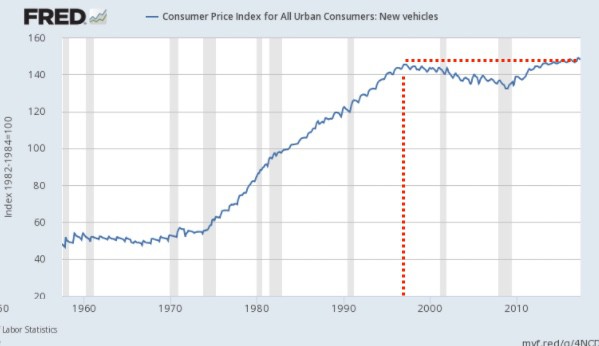
But your own eyes and personal experience may have noticed something different. If you've made a car purchase over the past 20 years, you've probably observed that actual out-of-pocket costs to purchase a new vehicle have steadliy risen from just over $19,000 in 1997 to over $33,000 today:
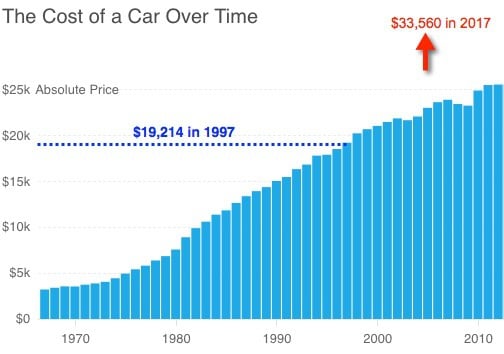
(Source)
Where the US government is convinced that cars costs exactly as much as they did 20 years ago, your personal experience might be that they are not terribly far away from costing 100% more.
The explanation for the difference is that the BLS has decided that today's automobile is vastly improved compared to that of 20 years ago. It believes that your dollar buys you nearly 100% more "car" than it did before, so the whole thing is a wash.
This is the magic of “hedonic improvements” which I am not entirely unsympathetic to. If things improve and we pay the same amount for them, then that’s a gain in living standards, of a sort.
But the idea that “inflation is too low” is anchored in the idea that we are paying the same for things today as we were yesterday. The very essence of cognitive dissonance is being told that things cost twice as much but they haven’t gone up in price.
That the issue at play here. While the Fed frets about inflation being too low -- you struggle to afford rising new car costs, as well as the skyrocketing associated fees like maintenance and insurance.
Another prime area for "fuzzy numbers" is in living expenses related to housing. According to the government, housing costs have been modestly rising by an average of less than 3% per year for a decade:
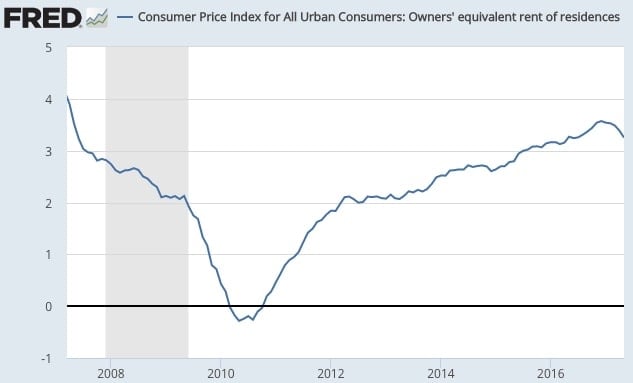
However, these charts from Charles Hugh Smith show that the price experience of homebuyers in many major metropolitan areas is anything but subdued:
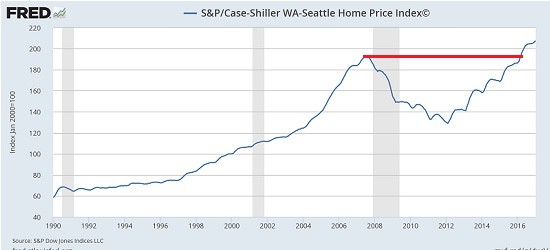
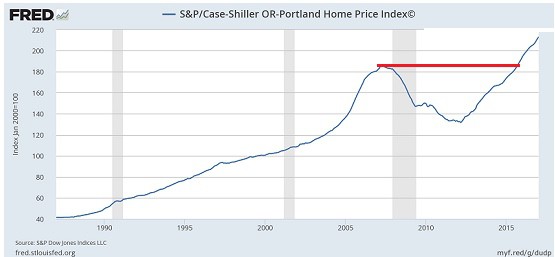
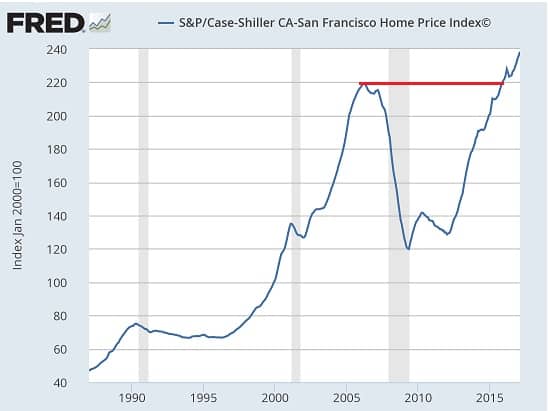
(Source)
Add all this up and what do you get?
A very different impression of the state of ‘the economy’ than Bloomberg is working hard to present.
And even more egregious than the misinformation is the complete inappropriateness for the media to praise economic 'strength' while ignoring the role of debt in bringing about the growth being celebrated. If the 'prosperity' is simply due to a drunken debt-binge, it should be criticized, not lauded.
The Pin To Pop This Mother Of All Bubbles?
Which brings us to a very important risk factor to the over-leveraged global economy: declining credit impulse.
Unfamiliar with the term? You won't be for long.
Defined as net new credit to GDP, credit impulse is one of the best statistical predictors of recession. As of today, credit impulse has gone negative across the world for the first time since the start of the Great Recession.
In Part 2: Everything You Need To Know About The Credit Impulse, we lay out the evidence for why there’s a credit impulse-driven recession on the way. It will come whether or not the underlying economy is recovering or not.
Why? Because the amount of debt creation was absolutely massive across the globe, particularly in China. The excessive debt service will simply overwhelm the economy -- it won't even be a close fight.
Click here to read the report (free executive summary, enrollment required for full access)
This is a companion discussion topic for the original entry at https://peakprosperity.com/the-pin-to-pop-this-mother-of-all-bubbles/
